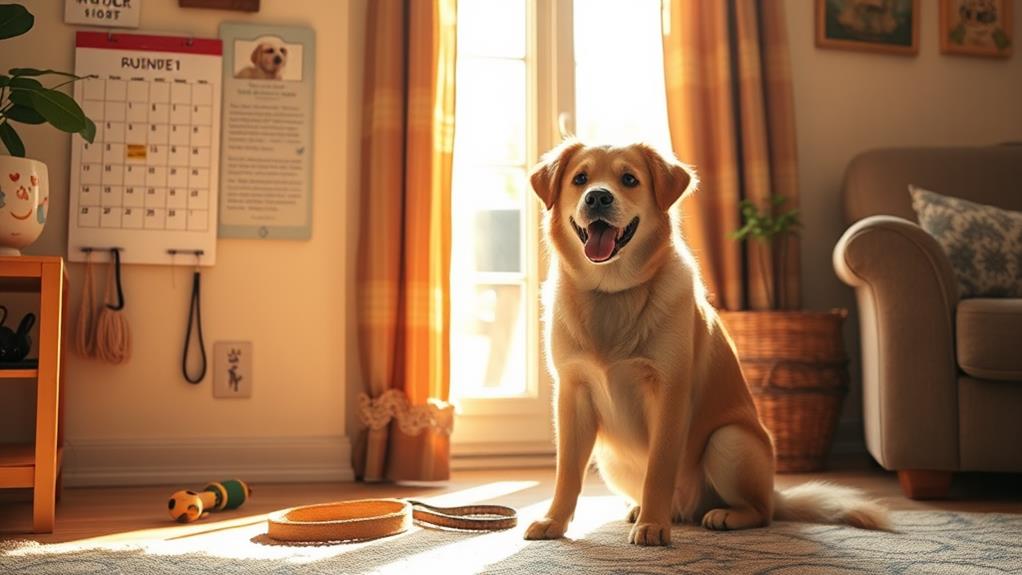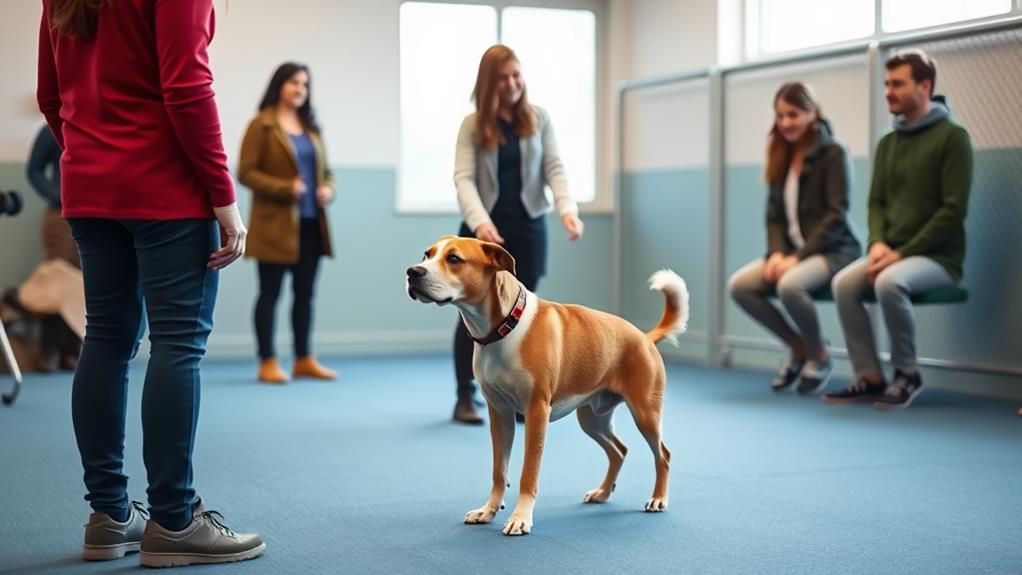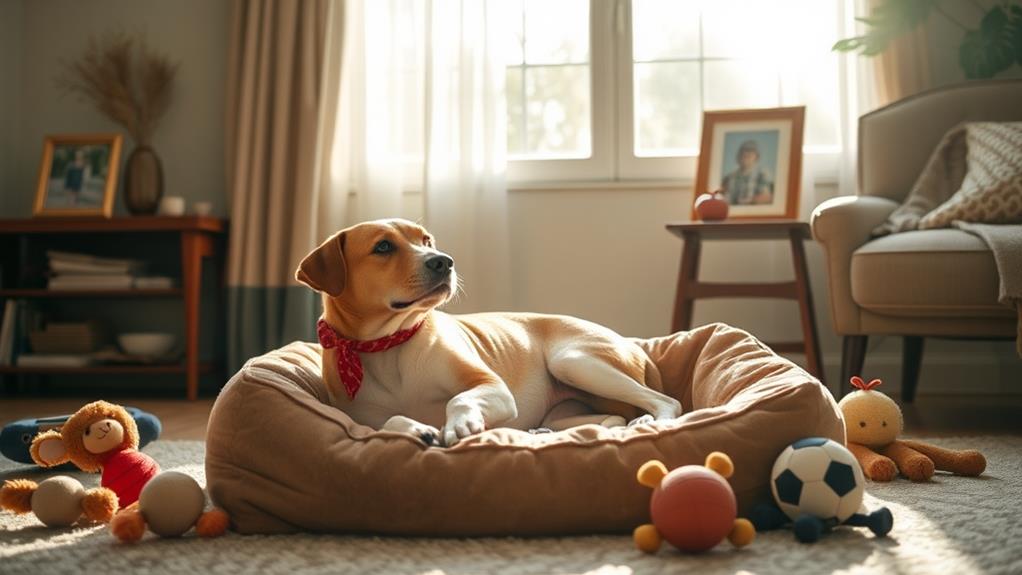If your dog struggles with separation anxiety, you can use effective training tips to help. First, understand the signs like barking and pacing. Establish a consistent routine to provide security, and practice gradual departures by leaving your dog alone for short periods. Create a safe space with familiar toys and bedding so they feel secure. Engage their mind with interactive toys and practice relaxation techniques together. If needed, seek professional help for tailored guidance. Monitor your dog's progress to see what's working. Keep exploring these strategies, as they're key to conquering anxiety and building a happier, calmer dog.
Understand Separation Anxiety

Separation anxiety is a common issue many dogs face when their owners leave them alone. You might notice your dog barking excessively, pacing, or showing destructive behavior when you prepare to leave. This anxiety stems from the strong bond dogs form with their owners, and it can lead to distress when they perceive a separation as a threat.
To understand this behavior, pay attention to your dog's body language. Signs like drooling, whining, or attempting to escape can indicate anxiety. It's fundamental to recognize that these actions aren't meant to be manipulative; they reflect genuine fear and discomfort.
You should also consider your dog's history. If you've recently moved, adopted a new pet, or experienced significant changes in your routine, your dog may need time to adjust. The key is to be patient and empathetic. Your understanding will help you identify triggers and develop strategies to gradually ease their anxiety. Remember, separation anxiety is manageable with the right approach. By recognizing the signs and understanding your dog's feelings, you're already on the path to helping them feel secure and confident when you're away.
Establish a Routine

Creating a consistent routine for your dog can vastly reduce anxiety and promote a sense of security. Dogs thrive on predictability, and when they know what to expect, they're less likely to feel stressed. Start by establishing regular feeding, walking, and playtimes. This structure helps your dog understand their day and reduces uncertainty.
Routine not only aids in reducing separation anxiety but also strengthens the bond between you and your dog. By following a structured daily schedule, you'll foster a calm environment that encourages your dog to feel secure. Remember, consistency is key, so stick to your plan as much as possible to reap the benefits for both you and your furry friend.
Here are some key elements to include in your routine:
- Feeding Times: Set specific times for meals, which can help regulate digestion and create a sense of stability.
- Exercise Schedule: Consistent daily walks or play sessions provide physical and mental stimulation, helping to release pent-up energy.
- Quiet Time: Designate periods for relaxation, such as nap time or quiet play, allowing your dog to unwind and recharge.
Gradual Departures

To help your dog feel more comfortable during your departures, gradually getting them used to being alone can make a significant difference. Start by leaving your dog alone for short periods, like just a few minutes. This initial step builds their confidence and shows them that you'll return.
Each time you leave, slowly increase the duration of your absences. If your dog seems anxious, reduce the time again and build up more slowly. Use positive reinforcement when you return to reward calm behavior. This could be a treat, praise, or playtime, reinforcing that being alone isn't something to fear.
Try to create a consistent routine around your departures. For instance, pick up your keys or put on your shoes to signal it's time to leave. This helps your dog anticipate your actions and understand what's happening.
Remember to keep your departures low-key. Avoid long farewells, as they can heighten anxiety. Instead, be calm and casual when you leave and return. With patience and persistence, your dog will learn that being alone is a normal part of life, making the experience easier for both of you.
Create a Safe Space

Establishing a safe space for your dog can markedly reduce anxiety during your departures. This space should feel comforting and secure, allowing your dog to relax while you're away. Start by choosing a quiet area in your home, away from the hustle and bustle, where your dog can retreat whenever needed.
Consider incorporating the following elements into their safe space:
- Comfortable bedding: Provide a soft bed or blanket that your dog loves. Familiar scents can enhance the feeling of security.
- Familiar toys: Include a couple of your dog's favorite toys. These can serve as distractions and provide comfort during your absence.
- Calm ambiance: Use calming music or a white noise machine to create a soothing environment. This helps drown out any sudden noises that might trigger anxiety.
Make this space inviting and accessible, so your dog knows it's their own sanctuary. Spend some time with them in this area to help them associate it with positive experiences. By doing this, you'll help your dog feel more at ease, making your departures less stressful for both of you.
Use Interactive Toys

Interactive toys can be a game-changer for keeping your dog engaged and mentally stimulated. These toys encourage your furry friend to think and problem-solve, which can help alleviate anxiety when you're away. By focusing on a challenge, they'll be less likely to notice your absence.
Here's a quick guide to some effective interactive toys:
| Toy Type | Benefits |
|---|---|
| Puzzle Feeders | Engage your dog's mind while rewarding them with treats as they work through the challenges. |
| Treat-Dispensing Balls | Keep your dog active as they roll the ball around to release treats, promoting physical exercise and mental engagement. |
| Tug Toys | Provide an outlet for your dog's natural instincts and help them bond with you during interactive playtime. |
| Squeaky Toys | Stimulate your dog's hunting instincts and keep them entertained with sounds that pique their curiosity. |
Practice Short Absences

Leaving your dog alone can be challenging, but practicing short absences is a great way to help them adjust. Start by leaving your dog alone for just a few minutes at a time. This helps them get used to your absence without feeling overwhelmed. Gradually increase the duration as they become more comfortable. You'll notice that their anxiety decreases as they learn you always come back.
- Choose a consistent time: Pick specific times for these short absences to create a routine. This helps your dog know what to expect.
- Make it a positive experience: Before you leave, give your dog a treat or engage them in a fun activity. This can help them associate your departure with something enjoyable.
- Stay calm during arrivals and departures: Keep your goodbyes and hellos low-key. If you make a big deal out of leaving or returning, your dog may feel more anxious.
Provide Comfort Items

Comfort items can notably ease your dog's anxiety when you're not home. These items can provide your pup with a sense of security and familiarity, helping them feel less alone. Start by identifying a few items that your dog loves. This might include a favorite blanket, a soft toy, or even a piece of your clothing.
When you leave, make sure to leave these comfort items with your dog. The scent of your clothing can be particularly soothing, as it reminds them of your presence. If your dog has a favorite toy, consider giving it a little extra love by playing with it together before you leave. This can help create a positive association with the toy.
You can also rotate comfort items to keep things fresh and engaging. Introducing new toys or blankets can prevent boredom and keep your dog mentally stimulated. Remember to avoid items that could pose a choking hazard or are easily destructible. Finally, guarantee that the chosen comfort items are safe and appropriate for your dog's size and chewing habits. With the right comfort items, you can help ease your dog's separation anxiety substantially.
Train Relaxation Techniques

Once your dog has some comfort items to ease their anxiety, it's time to incorporate relaxation techniques into their routine. These techniques can help your dog feel more secure and calm when you're away.
Start by practicing deep breathing exercises with your dog. Sit quietly together and take slow, deep breaths, encouraging your dog to mimic your pace. This helps them associate calmness with your presence.
Another effective technique is progressive muscle relaxation. Guide your dog through tensing and relaxing different muscle groups, starting from their paws and moving up to their head. This practice can help release built-up tension and promote relaxation.
Lastly, consider using calming music or nature sounds during your training sessions. Play these soothing sounds in the background as you work on other training strategies. Over time, your dog will learn to associate these sounds with a safe and relaxed environment.
- Practice deep breathing exercises together
- Use progressive muscle relaxation techniques
- Play calming music or nature sounds during training
Incorporating these relaxation techniques won't only support your dog's emotional well-being but also strengthen your bond.
Seek Professional Help

When you're struggling to train your dog effectively, seeking professional help can make a significant difference. Often, a professional dog trainer brings expertise and experience that can help you understand your dog's specific needs. They can assess your dog's behavior and provide tailored strategies to address separation anxiety.
Consider finding a trainer who specializes in behavior issues. They'll guide you through training techniques that are proven to work. You might feel overwhelmed, but a professional can break down the process into manageable steps, ensuring you don't feel lost.
Additionally, trainers can offer valuable insights into your dog's body language and signals. This understanding can help you recognize when your dog is anxious and how to respond effectively. Group classes can also be beneficial, allowing your dog to socialize with others while under the guidance of a trainer.
Don't hesitate to reach out for help. Investing in professional training can pave the way for a happier, more secure relationship between you and your dog. Remember, addressing separation anxiety is a journey, and having the right support can lead to lasting changes.
Monitor Progress

Monitoring progress is pivotal for effective dog training. You need to track your dog's behavior changes to guarantee the training methods you're using are working. Regularly evaluating their reactions will help you identify what's effective and what needs adjustment. This process not only keeps you informed but also builds your confidence as a trainer.
To effectively monitor your dog's progress, consider these strategies:
- Daily Journaling: Write down your dog's behaviors and responses to different training exercises. This helps you spot trends over time.
- Video Recordings: Capture training sessions on video. Watching them later allows you to notice subtle improvements or setbacks that you might overlook in the moment.
- Set Specific Goals: Establish clear, measurable objectives for your dog's training. Whether it's reducing barking or improving crate comfort, having defined goals makes it easier to assess progress.
Frequently Asked Questions
Can Separation Anxiety Affect All Dog Breeds Equally?
Yes, separation anxiety can affect all dog breeds, but some breeds may be more prone due to their temperament and attachment styles. It is critical to recognize your dog's unique needs and address any anxiety issues promptly.
Are There Age Differences in How Dogs Experience Separation Anxiety?
Yes, age matters. Puppies might not fully understand separation, while older dogs often have established bonds, making them more prone to anxiety. Your dog's experiences and maturity level can profoundly influence their response to being alone.
How Long Does It Usually Take to See Improvement in My Dog?
It's a journey, not a race. You might notice improvements in your dog's behavior within a few weeks, but patience is key. Consistent training and positive reinforcement go a long way toward easing their worries.
What Medications Are Available for Severe Separation Anxiety in Dogs?
For severe separation anxiety in dogs, your vet might prescribe medications like fluoxetine or clomipramine. These can help calm your dog, but always consult your vet before starting any treatment to verify it's appropriate.
Can Separation Anxiety Lead to Other Behavioral Problems in Dogs?
"An ounce of prevention's worth a pound of cure." If your dog experiences separation anxiety, it can indeed lead to other behavioral issues like destructive chewing or excessive barking, making early intervention essential for their well-being.
Conclusion
By understanding and addressing your dog's separation anxiety, you can help them feel more secure and relaxed when you're away. Did you know that nearly 20% of dogs experience some form of separation anxiety? With the right training techniques and a bit of patience, you can reduce their stress and improve their quality of life. So, start implementing these tips today, and watch your furry friend thrive in your absence!



